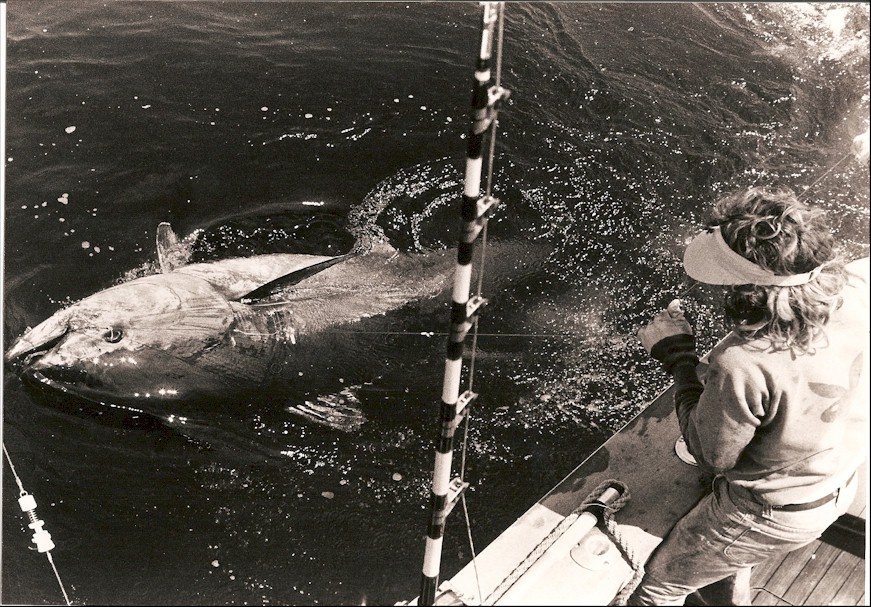|
Daisy Chains - A little History Daisy Chains have been used for decades, maybe even longer. I started fishing professionally in 1974 and they were being used at that time as teasers by Sailfishermen in South Florida. I rigged my first Daisy Chain with a hook in the tailing bait in 1976 on around July 6th in Gloucester, Ma. I was taught that day how to harness up Boston Mackerel as "teasers" and tie them with Dental floss to the leader ahead of a larger Boston Mackerel that I had rigged as a "hook bait" at the end. I rigged seven or so that day as they lasted around 5 hours each and we trolled three lines for Giant Tunas. The Daisy Chains I rigged put on a nice display splashing along in unison across the slick calm water in MASS Bay. It was a slow day for sure as when it became around 5:00 PM and we had gone without a strike, the captain announced we had "Five More Minutes". Well the fish must have heard him as around four and a half minutes later we hooked up! Not one, but two Giants! They got tangled and as I was a "Green" mate at the time, we cut one loose so as not to break them both off. The one we landed was a "rat" (small) but still weighed in at 410 lbs. This was my very first fish caught on a Daisy Chain. In the coming weeks, I rigged more and more chains, to the point where I could probably do it blind folded. We were catching around 1.5 giants per day averaging around 900 lbs each! This is when I became a true believer in Daisy Chains as we caught no fewer than 40 on Daisy Chains before we switched to chuming after the New York boats showed up. At that time, we used Boston Mackerel and large squid for our baits, but the captains had spoken about a particular type of rubber squid that used to be produced that was very productive, but they couldn't find them any more. In the last 30 years more and more manufacturers have entered the lure market and many of us have made "Shell Squids". These have been sold to tackle retailers who produce both Daisy Chains and Spreader Bar Rigs, and I do not know of anyone who does it anymore the way we did way back when (with real baits) as (Good) Shell Squids are so productive.
This Giant was caught using a Daisy Chain of six Boston Mackerel. This is Dave Adams on the wire Daisy Chains - Why they Work 1. The first thing you need to know, is that genearlly speaking, the first thing that attracts a fish's attention is not the trolling bait, but the boat, the engines, the prop wash, the "hum" as Alex Adler calls it. 2. After you have the fish's attention, and he looks up, if you have out three or four Daisy Chains, instead of seeing three or four single baits, the fish now sees a huge Buffet! Whao!? The fish thinks "Breakfast!" 3. When the fish comes up for a look at the buffet you have laid out for him he notices that there is a small predator chasing a group of smaller baits. Instinctively the fish knows that the small predator (your hook bait) is distracted by the chase he is on for a meal and the fish knows that this small predator is an easy target, so he jumps on it! The photo below PROVES this theory.
Think about it... These guys are going through all this trouble not because it is fun, but because it is worth it. Now, for us "Weekend Warriors" fishing with smaller boats or smaller budgets, it is not at all practical to go through this type of expense or trouble. But, what we can do to increase our chances is to deploy Daisy Chains and Spreader Bar rigs. While a Daisy Chain is incredibly simple and very economical, for a bit more money and a slight more effort, Spreader Bar rigs can increase your Buffet's size even more. Our Standard Spreader Bar Rig has a total of 14 baits on it, so if you drag only one and two five bait DaisyChains, you now have 24 baits running from three rod tips (instead of three baits). Take a tip from the Pros Fishing South Florida I am now personally dragging three Daisy Chains in my five to six line spread. I only drag a spreader bar rig when it is fairly calm and/or I have at least one helpful person aboard. It does produce well, but on a particular day I had in 2009, we caught 8 fish on a Green/Yellow Bone Head Stinger Chain behind our Mackerel Bird, one fish on a Rainbow Spreader Bar Rig, and zero on any of the four single baits behind the boat. Several other days with only one or two Daisy Chains out have ended up with 80 - 90% of all trolling fish caught on a Daisy Chain. This is why I am now dragging three. For the record, I have not trolled any "Meat" (no Ballyhoo, Mullet, Strips, etc) since 2009 and we have been doing extraordinarily well. This is not to suggest trolling Ballyhoo or other meat is not good, but you can be very successful without it. My suggestion is to drag no fewer than two Multi Bait rigs, whether they be a Daisy Chain or a Spreader Bar Rig. Troll them from the corners on flat lines about twenty feet back of your prop wash. Troll a Single bait (or another Daisy Chain) in the center 15 feet in front of these (or 5 feet behind the prop wash). For me, this is usually a Tuna Bandit or a Marlin Lure, but yesterday I was trolling a Daisy Chain in this position. Then, troll two other baits each around twenty feet behind each Daisy Chain. These could be Ballyhoo from your riggers. Then troll a single bait WFB (Way Freakin Back) around 150 - 200 feet behind the boat. I will use a Wahoo Bait if they are around, or a Tuna Bait if they are around. My usual is a Steel Head as it catches everything and it is exceptional on everything. I can almost guarantee that your success will increase by adopting Daisy Chains as your "Go to" baits when Targeting Dolphin, Wahoo, and Tuna. You will also likely find a Sailfish or Marlin eat one if you drag it by one.
To get to Our Daisy Chain Page To get to Our Spreader Bar Page |











































